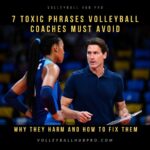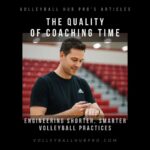
| Author | John J. Miller |
| Article Depth | In-depth |
| Required Knowledge | Basic Coaching Principles |
| Primary Audience | Volleyball Coaches |
Forging Resilience
Every athletic journey is marked by moments of difficulty, those phases where the fluidity of play falters, confidence wavers, and the group seems to lose its way. A team’s ability to navigate these negative junctures, to avoid sinking at the first sign of trouble, is often what distinguishes solid squads from fleeting ones. Managing such dynamics presents one of the most complex yet stimulating challenges for a coach.
The fundamental starting point lies in the awareness that primary responsibility for a group’s decline should be sought in one’s own strategies and communication. Instead of focusing on the athletes’ shortcomings, it is more productive to question potential errors in weekly preparation, in-game tactical management, or the communicative methods employed. These aspects, indeed, are trainable and improvable, and depend directly on the coach’s approach. It’s not merely about “telling” the team what to do, but about inducing a shift in their perception of situations, in their way of confronting adversity.
When intervening with a group in crisis, perhaps taking over mid-season, one can benefit from the “novelty” effect: athletes are generally more receptive and eager to reverse a negative trend. In these contexts, the impact can be more immediate, working both on the court with targeted drills and on aspects that modify the overall perspective.
One of the most common manifestations of fragility is the tendency to lose composure after an error or a conceded point, triggering a negative spiral. Teaching how to “stay in the game” is not an abstract concept, but a skill that is cultivated. The use of video material can prove to be a powerful tool. Analyzing with the team examples of squads that, even under adverse conditions—being a player down, trailing in the score, environmental pressure—managed to maintain tactical and mental compactness, offers concrete models of reaction. A detailed explanation of how such teams handled critical moments, their correct movements, and their ability to avoid “losing their cool” provides tangible reference points. It is not enough to state the principle; its practical application must be illustrated.
Daily training is the primary laboratory for forging this resilience. It is crucial to design drills that not only refine technique and tactics but also implicitly teach how to manage pressure and react to difficulties. An effective example could be organizing internal tournaments with specific rules: a three-team structure where the winning team stays on the court, stimulating competitiveness and the desire to remain in play. Further variations, such as stipulating that victory is achieved by reaching a two-point lead (or a mini-set to a lower score), introduce relevant psychological dynamics. Scoring a point should not mean letting one’s guard down, but pushing for another; conceding one should not lead to resignation, but to an immediate attempt at recovery and a strenuous defense of the next point. These mechanisms, when repeated, tend to automate positive behaviors, eliminating the tendency to hang their heads at the first hurdle.
The goal is to rid players of the habit of thinking “well, it’s over,” replacing it with a proactive approach: “What do I need to do now? How can I turn this situation around?” This is more easily achieved through practical experience, through “doing,” rather than through lengthy speeches. Words, while important, must be supported and actualized by action on the court. True internalization of a principle occurs when it is lived and automated, not merely rationalized.
The immediate reaction to a conceded point is a key indicator. The mentally strong athlete, when faced with an error or an opponent’s point, should channel frustration into heightened concentration and controlled aggression. Similarly, whoever scores should avoid a drop in intensity, maintaining or even elevating the pace. Some teams, after scoring a point, immediately intensify their pressure, perhaps with a more aggressive serve or increased assertiveness in blocking and defense. These are behavioral “anchors” that can be trained, for instance, by mandating that the team that just scored must immediately execute a specific tactical action with maximum intensity.
It is a common mistake, especially for less experienced coaches, to overdo verbal explanations in an attempt to ensure the message is understood. Often, however, an excess of words can dilute the message’s impact or, worse, fail to translate into actual change on the court. It is preferable to create training situations that naturally induce the desired behaviors, allowing solutions to emerge from the athletes’ direct experience. The real challenge lies in creating positive states of mind and automatisms, rather than relying solely on reasoning and speeches, however well-articulated.
Even managing external interferences, such as comments from management or other club figures, requires skill. It is fundamental that the final word, the one that concretely directs the work, comes from the coach. Any external input, even if potentially destabilizing, can be reframed and presented to the group in a constructive light, perhaps not immediately, but at a more opportune subsequent moment, on the court, with a few, targeted instructions.
Consistency and intellectual honesty are crucial. Admitting one’s own misjudgment or a difficulty is not a sign of weakness but strengthens credibility. If the adopted strategies do not yield the desired results, stubbornly insisting on one’s infallibility undermines the group’s trust. Acknowledging an error allows for a change of course and maintains an open, constructive dialogue with the team. It is also important to avoid clichés and platitudes (“more grit,” “show some heart”), which rarely offer concrete solutions. Athletes seek answers, clear guidance on how to improve and what to do on the court.
Emotional Contagion and Functional Leadership
Beyond direct intervention strategies and targeted drill programming, a coach’s ability to navigate difficult phases is enhanced by understanding and managing more subtle, yet significantly impactful, psycho-social dynamics. Among these, the phenomenon of emotional contagion, with its deep neurophysiological roots, and the development of functional, distributed leadership within the on-court sextet, emerge as crucial levers for team self-organization and resilience.
Emotional contagion describes how moods and attitudes can rapidly spread within a group, inevitably influencing collective performance. This process is not random but is grounded in the mirror neuron systems within our brains. These neural circuits activate similarly whether we are performing an action or experiencing an emotion, or when we observe someone else exhibiting analogous behaviors or emotions. In a team context, if the coach or a player perceived as a key figure displays anxiety, frustration, or resignation through body language—slumped shoulders, irate gestures, tense facial expressions—or tone of voice, the mirror neurons of other members can trigger an emotional resonance, facilitating a rapid spread of that negative state. Conversely, a coach capable of projecting calm, determination, and confidence, even under pressure, can act as an “emotional anchor,” positively “infecting” the group. This composure is not synonymous with passivity but translates into the ability to project confidence in the group’s resources, providing clear and constructive guidance rather than impulsive reactions. The bench, and particularly the coach, becomes an emotional barometer: the team observes, consciously or unconsciously, their leader’s reactions to calibrate their own response to the situation.
Consistent with Albert Bandura’s Social Learning Theory, the coach acts as a primary model. The way the coach reacts to a referee’s error, a series of conceded points, or the tension of a set’s end, is observed and often, unconsciously, imitated by the athletes. A reaction characterized by control, focus on the solution, and encouragement promotes the adoption of a similar constructive approach by the players. The coach’s ability to self-regulate their own emotions thus becomes fundamental. Problem-focused coping strategies, such as lucidly analyzing the situation and planning the next action, are generally more effective than emotion-focused ones, like venting anger or ruminating on an error. Demonstrating adaptive coping, including the ability for cognitive restructuring—reinterpreting a stressful event in terms of future learning—is a powerful self-regulation tool that can be implicitly transmitted. It’s important to consider that intense negative emotions can narrow the attentional field, inducing a kind of “tunnel vision” that causes athletes to miss crucial cues and make suboptimal decisions. A positive emotional climate, conversely, fosters greater attentional breadth and cognitive flexibility. Creating such a climate does not mean ignoring mistakes, but addressing them in a supportive context, using specific and constructive feedback and reinforcing effort even in difficult moments.
Parallel to the coach’s role, a group’s ability to self-regulate during challenging times significantly depends on the presence and effectiveness of distributed and functional leadership on the court. Although the designated captain holds a formal role, it is desirable for multiple athletes within the sextet to be capable of assuming communicative and encouraging responsibilities. An effective team, indeed, possesses shared mental models regarding tasks, roles, and strategies, especially under pressure. Distributed leadership helps create and maintain these models. When an on-court player-leader recalls a play, reinforces a tactical principle, or offers a targeted word of encouragement, they contribute to keeping the team “on the same page.” The coach can actively build these models during training, simulating game situations and encouraging players to actively communicate solutions and adjustments.
By adopting principles of transformational leadership, the coach can cultivate internal leaders by inspiring a clear vision, intellectually stimulating autonomous problem-solving, individually considering athletes’ needs, and acting as a model of integrity. This approach empowers athletes and develops their leadership capabilities. These informal leaders provide crucial immediate social support to teammates—emotional, informational, or tangible—which correlates with greater collective efficacy, the shared belief in the group’s ability to succeed. It is essential that these on-court leaders are skilled communicators, using assertive, clear, direct, respectful, and constructive language. Teaching and modeling these communication skills during training is a valuable investment. Even in a distributed leadership system, role clarity is fundamental, as is an environment of psychological safety, where athletes feel free to express themselves and make mistakes without fear of negative repercussions, instead viewing them as learning opportunities.
The Guides of Volleyball Hub Pro
If you’re looking to delve deeper into this topic, we highly recommend reading the following books authored by our team:

















Leave a Reply
You must be logged in to post a comment.